Temperature Load Mode of Bridge in Permafrost Region of Qinghai–Tibet Railway
Abstract
:1. Introduction
2. Test Scheme
2.1. Test Method
2.2. Test System Composition, Layout, and Verification
3. Test Result
3.1. Monitoring Results and Analysis of Beam Temperature
3.2. Monitoring Results and Analysis of Beam-Rail Longitudinal Displacement
4. Finite Element Model
4.1. Sunshine Temperature Field Simulation Model
4.2. Model Validation
5. Finite Element Analysis Results
5.1. Distribution Law of Beam Temperature Difference
5.2. Distribution Law of Temperature Field
6. Temperature Effect Analysis
7. Conclusions
- (1)
- The daily temperature difference of a concrete two-piece T-beam bridge in the Qinghai–Tibet railway area presents a large value from November to March of the next year, which is mainly related to the ground’s effective radiation and surface reflectivity.
- (2)
- The maximum daily temperature difference of the beam body in the Za’gya Zangbo region is 17.8 °C, exceeding the 15 °C specified in Code for Design of Railway Continuously Welded Rail. It is suggested that when designing bridges in plateau areas, the beam’s temperature difference should be increased as appropriate to ensure the durability requirements of bridge in operation. In addition, observation and analysis should be further strengthened to provide important data support for revising and perfecting the codes.
- (3)
- Through long-term field test and simulation calculation, it is found that under the conditions of strong radiation and large daily temperature difference in the Qinghai–Tibet railway area, the bridge frequently produces telescopic displacement, which can easily lead to the attenuation of the performance of rail fasteners and bridge bearings and has an adverse impact on the safety of track structure. It is suggested that the maintenance of the bridge structure be strengthened and that performance index of bearing in this area be improved.
- (4)
- Based on the measured data and heat transfer simulation analysis, the temperature difference load mode suitable for concrete two-piece T-beams in typical areas of the Qinghai–Tibet railway was proposed. This study overcomes the deficiency of regional limitations in the existing research, and makes up for the deficiency that the relevant codes do not consider the plateau’s special climatic conditions, which can provide a reference for the design of CWR on a bridge in the plateau. Furthermore, the temperature load modes of other types of bridges need to be further studied.
Author Contributions
Funding
Institutional Review Board Statement
Informed Consent Statement
Data Availability Statement
Conflicts of Interest
References
- Zhang, L.; Gao, L.; Zhao, L.; Chen, K. Spatial and temporal characteristics of global solar radiation over Qinghai-Tibitan plateau based on ITPCAS dataset. Acta Energ. Sol. Sin. 2019, 40, 2521–2529. (In Chinese) [Google Scholar]
- Liu, F.; Chen, Q.; Zhang, Y.; Zhou, Q.; Li, C.; Cao, S. The characteristics of natural hazard regional combination law along the Qinghai-Tibet railway. Sci. Geogr. Sin. 2010, 30, 384–390. (In Chinese) [Google Scholar]
- TB10015-2012; Chinese National Standards, Code for Design of Railway Continuously Welded Rail. China Railway Publishing House: Beijing, China, 2013. (In Chinese)
- Fan, J.; Liu, Y.; Liu, C. Experiment study and refined modeling of temperature field of steel-concrete composite beam bridges. Eng. Struct. 2021, 240, 112350. [Google Scholar] [CrossRef]
- Li, H.; Zhang, Z.; Deng, N. Temperature field and gradient effect of a steel-concrete composite box girder bridge. Adv. Mater. Sci. Eng. 2021, 2021, 9901801. [Google Scholar] [CrossRef]
- Abid, S.; Mussa, F.; Tayşi, N.; Özakça, M. Experimental and finite element investigation of temperature distributions in concrete-encased steel girders. Struct. Control Health Monit. 2017, 25, e2042. [Google Scholar] [CrossRef]
- Abid, S.; Taysi, N.; Ozakca, M. Experimental analysis of temperature gradients in concrete box-girders. Constr. Build. Mater. 2016, 106, 523–532. [Google Scholar] [CrossRef]
- Lei, X.; Fan, X.; Jiang, H.; Zhu, K.; Zhan, H. Temperature field boundary conditions and lateral temperature gradient effect on a PC box-girder bridge based on real-time solar radiation and spatial temperature monitoring. Sensors 2020, 20, 5261. [Google Scholar] [CrossRef] [PubMed]
- Xiao, F.; Hulsey, J.; Balasubramanian, R. Fiber optic health monitoring and temperature behavior of bridge in cold region. Struct. Control Health Monit. 2017, 24, e2020. [Google Scholar] [CrossRef]
- Zhu, J.; Meng, Q. Effective and fine analysis for temperature effect of bridges in natural environments. J. Bridge Eng. 2017, 22, 04017017. [Google Scholar] [CrossRef]
- Taysi, N.; Abid, S. Temperature distributions and variations in concrete box-girder bridges: Experimental and finite element parametric studies. Adv. Struct. Eng. 2015, 18, 469–486. [Google Scholar] [CrossRef]
- Song, Z.; Xiao, J.; Shen, L. On temperature gradients in high-performance concrete box girder under solar radiation. Adv. Struct. Eng. 2012, 15, 399–415. [Google Scholar] [CrossRef]
- Xue, J.; Lin, J.; Briseghella, B.; Tabatabai, H.; Chen, B. Solar radiation parameters for assessing temperature distributions on bridge cross-sections. Appl. Sci. 2018, 8, 627. [Google Scholar] [CrossRef] [Green Version]
- Kennedy, J.; Soliman, M. Temperature distribution in composite bridges. J. Struct. Eng. 1987, 113, 475–482. [Google Scholar] [CrossRef]
- Branco, F.; Mendes, P. Thermal actions for concrete bridge design. J. Struct. Eng. 1993, 119, 2313–2331. [Google Scholar] [CrossRef]
- Sheng, X.; Yang, Y.; Zheng, W.; Zhou, B.; Li, S.; Huang, L. Study on the time-varying temperature field of small radius curved concrete box girder bridges. AIP Adv. 2020, 10, 105013. [Google Scholar] [CrossRef]
- Song, X.; Melhem, H.; Li, J.; Xu, Q.; Cheng, L. Effects of solar temperature gradient on long-span concrete box girder during cantilever construction. J. Bridge Eng. 2016, 21, 4015061. [Google Scholar] [CrossRef]
- Kim, S.; Park, S.; Wu, J.; Won, J. Temperature variation in steel box girders of cable-stayed bridges during construction. J. Constr. Steel Res. 2015, 112, 80–92. [Google Scholar] [CrossRef]
- Zhou, L.; Xia, Y.; Brownjohn, J.; Koo, K. Temperature analysis of a long-span suspension bridge based on field monitoring and numerical simulation. J. Bridge Eng. 2016, 21, 04015027. [Google Scholar] [CrossRef]
- Lu, H.; Hao, J.; Zhong, J.; Wang, Y.; Yang, H. Analysis of sunshine temperature field of steel box girder based on monitoring data. Adv. Civ. Eng. 2020, 2020, 9572602. [Google Scholar] [CrossRef]
- Mohan, K.; Sreemathy, J.; Saravanan, U. Numerical investigation into thermal load responses of steel railway bridge. IOP Conf. Ser. Earth Environ. Sci. 2017, 80, 012042. [Google Scholar] [CrossRef] [Green Version]
- Gu, B.; Xie, F.; Lei, L.; Gao, W. Computational method for 3D sunshine temperature field of long-span bridge structures. J. Southeast Univ. Nat. Sci. Ed. 2019, 49, 664–671. (In Chinese) [Google Scholar]
- Lu, Y.; Li, D.; Wang, K.; Jia, S. Study on solar radiation and the extreme thermal effect on concrete box girder bridges. Appl. Sci. 2021, 11, 6332. [Google Scholar] [CrossRef]
- Wang, Y.; Zhan, Y.; Zhao, R. Analysis of thermal behavior on concrete box-girder arch bridges under convection and solar radiation. Adv. Struct. Eng. 2016, 19, 1043–1059. [Google Scholar] [CrossRef]
- Lou, P.; Zhu, J.; Dai, G.; Yan, B. Experimental study on bridge–track system temperature actions for Chinese high-speed railway. Arch. Civ. Mech. Eng. 2018, 18, 451–464. [Google Scholar] [CrossRef]
- Shi, T.; Zheng, J.; Deng, N.; Chen, Z.; Guo, X.; Wang, S. Temperature load parameters and thermal effects of a long-span concrete-filled steel tube arch bridge in Tibet. Adv. Mater. Sci. Eng. 2020, 2020, 9710613. [Google Scholar] [CrossRef] [Green Version]
- Gottsäter, E.; Ivanov, O.L.; Miklós, M.; Plos, M. Validation of temperature simulations in a portal frame bridge. Structures 2018, 15, 341–348. [Google Scholar] [CrossRef]
- Yan, B.; Cheng, R.; Xie, H.; Zhang, X. Vertical nonlinear temperature gradient and temperature load mode of ballastless track in China. Mathematics 2022, 10, 120. [Google Scholar] [CrossRef]
- Wang, J.; Fang, Z. Temperature variation of concrete box girder bridge. J. Hunan Univ. Nat. Sci. 2008, 4, 23–28. (In Chinese) [Google Scholar] [CrossRef]
- Hu, Q.; Gao, M.; Wang, S.; Zhang, J. Calculating and using solar radiation in Qinghai-Tibit Pleteau. J. Lanzhou Jiaotong Univ. 2005, 4, 62–66. (In Chinese) [Google Scholar]
- Li, R.; Yang, W.; Ji, G.; Zhao, J. Parameterization of effective radiation over the Qinghai-Tibet Pleteau. Acta Energ. Sol. Sin. 2006, 3, 274–278. (In Chinese) [Google Scholar]
- Jiang, X.; Li, Y. Climatological characteristics of surface radiation over the Tibetan Plateau. Resour. Sci. 2010, 32, 1932–1942. (In Chinese) [Google Scholar]
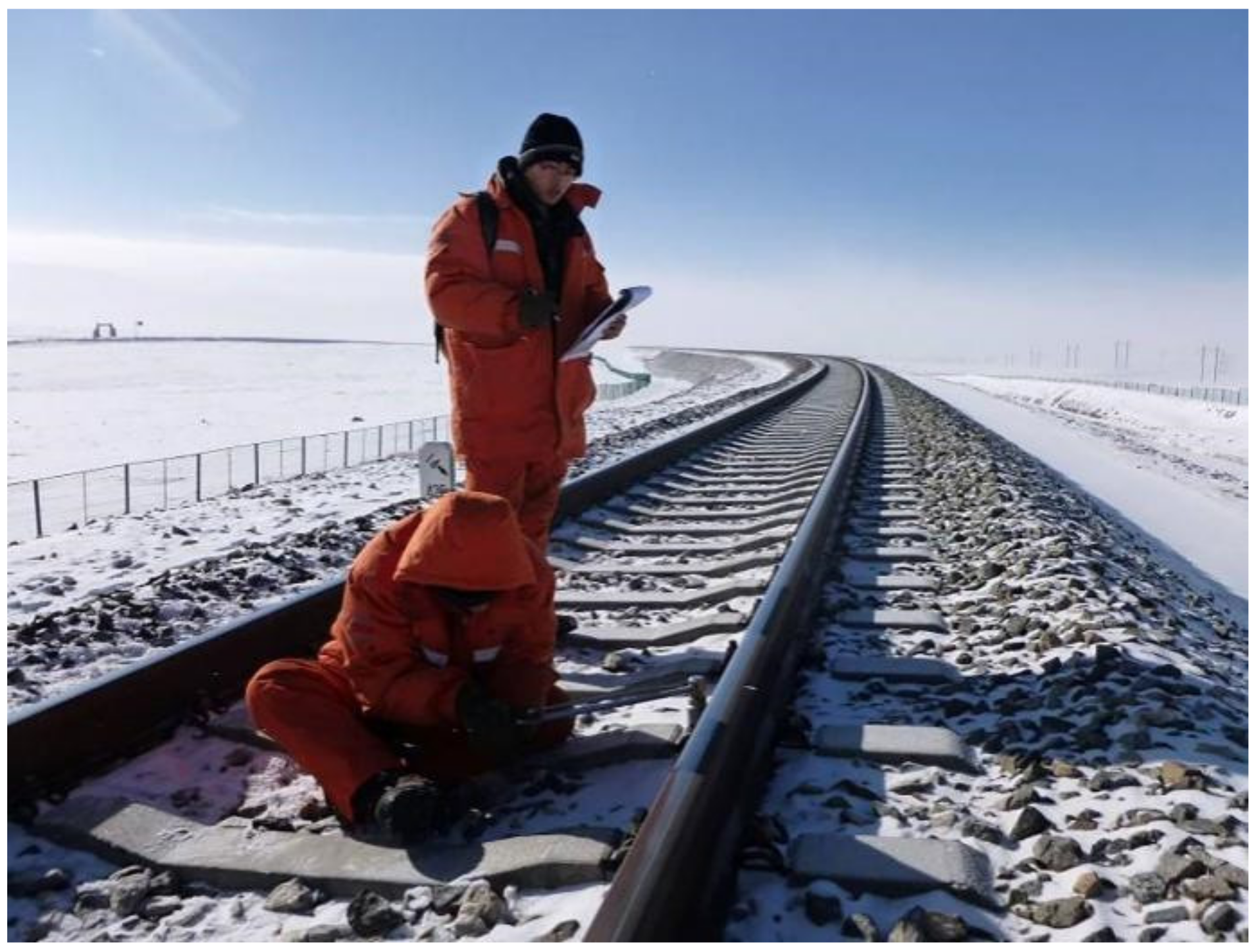

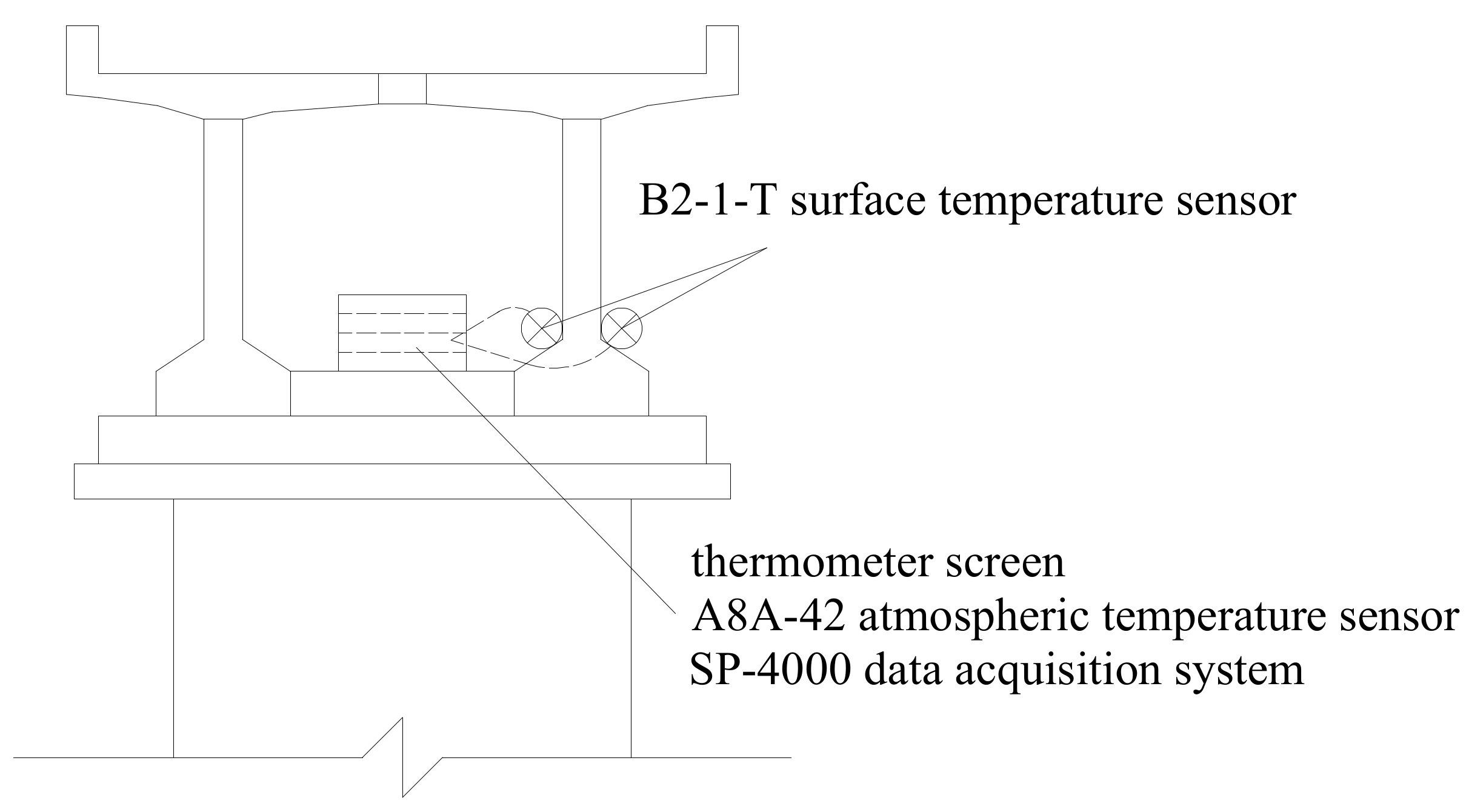
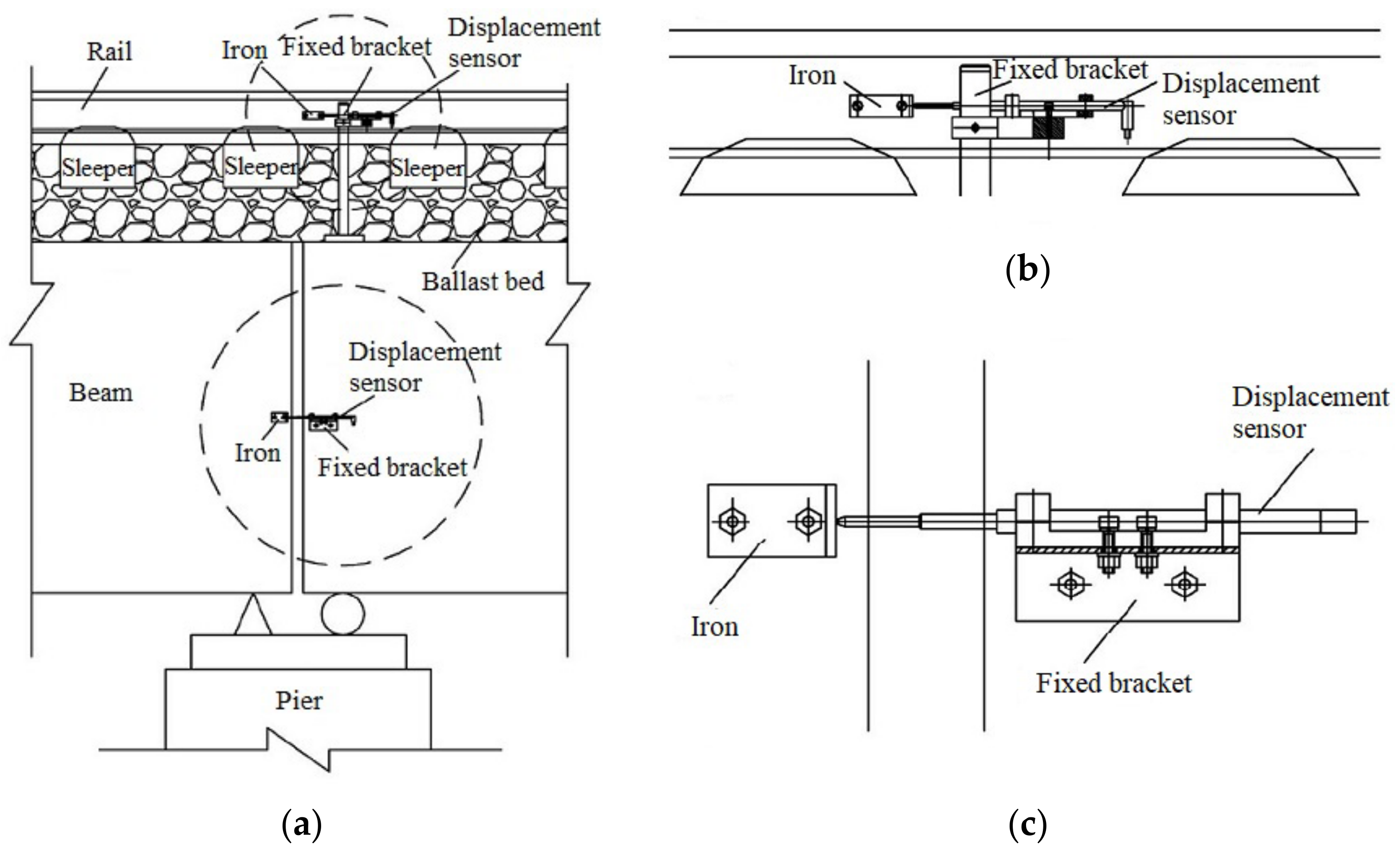
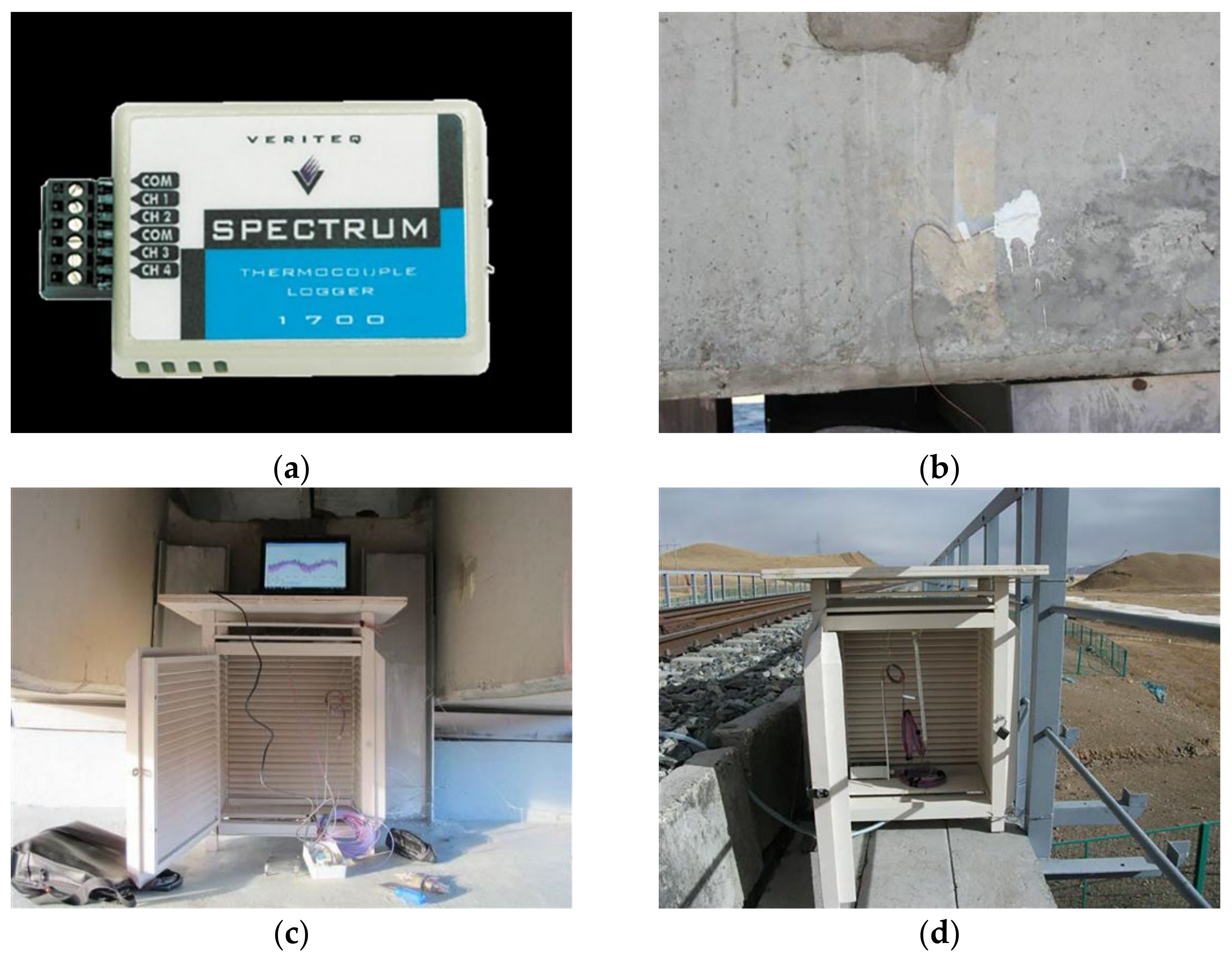

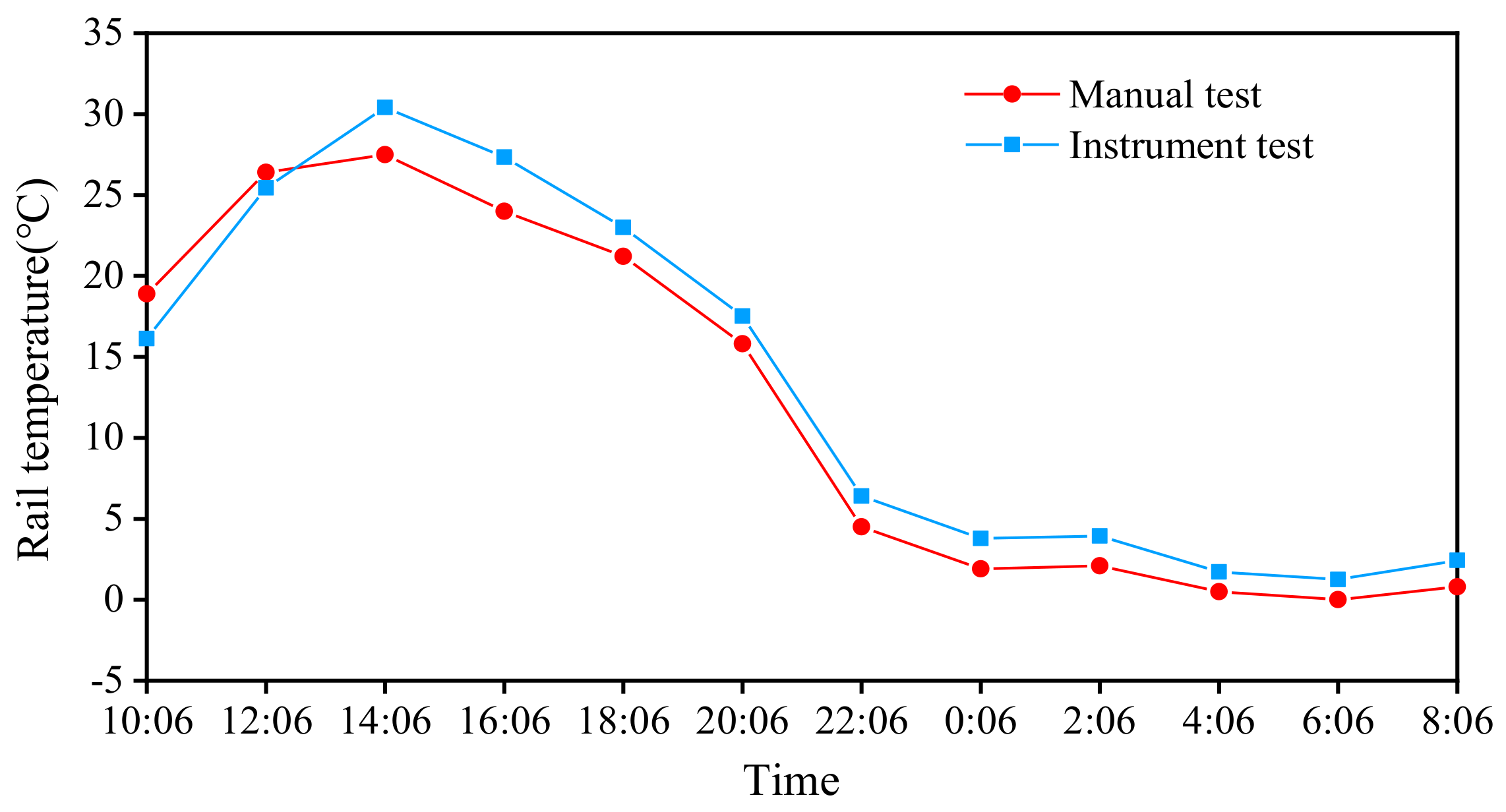
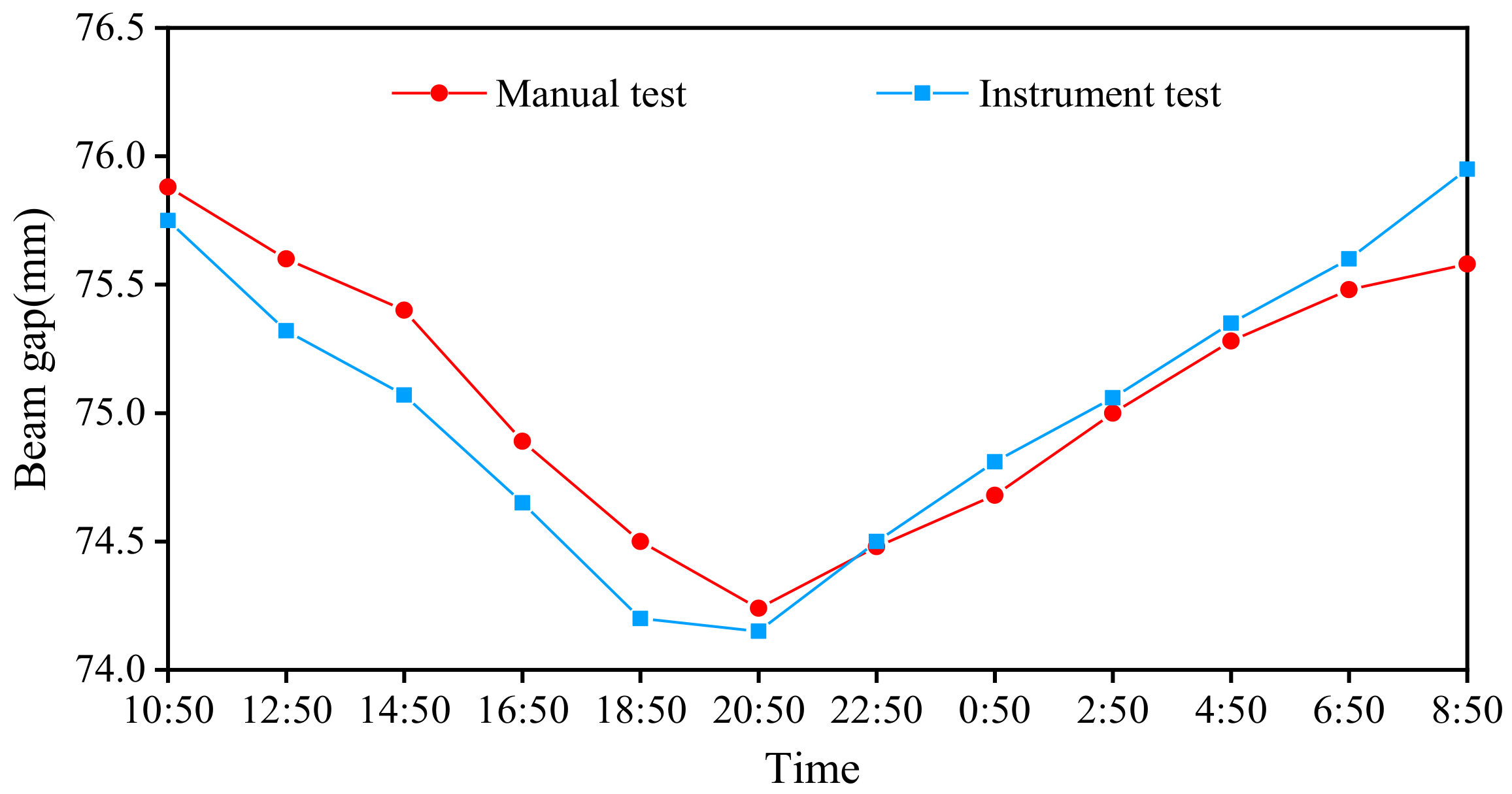
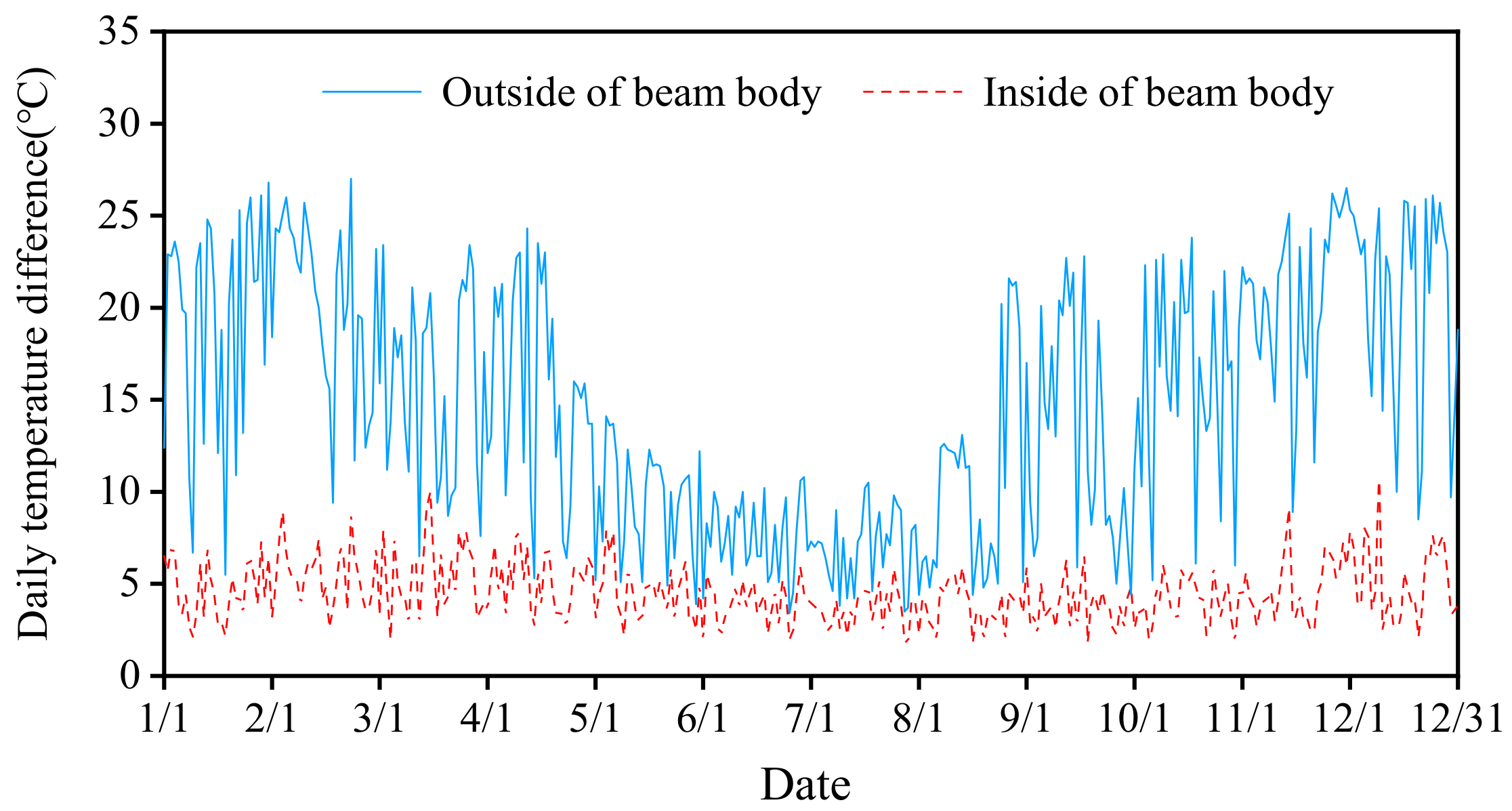
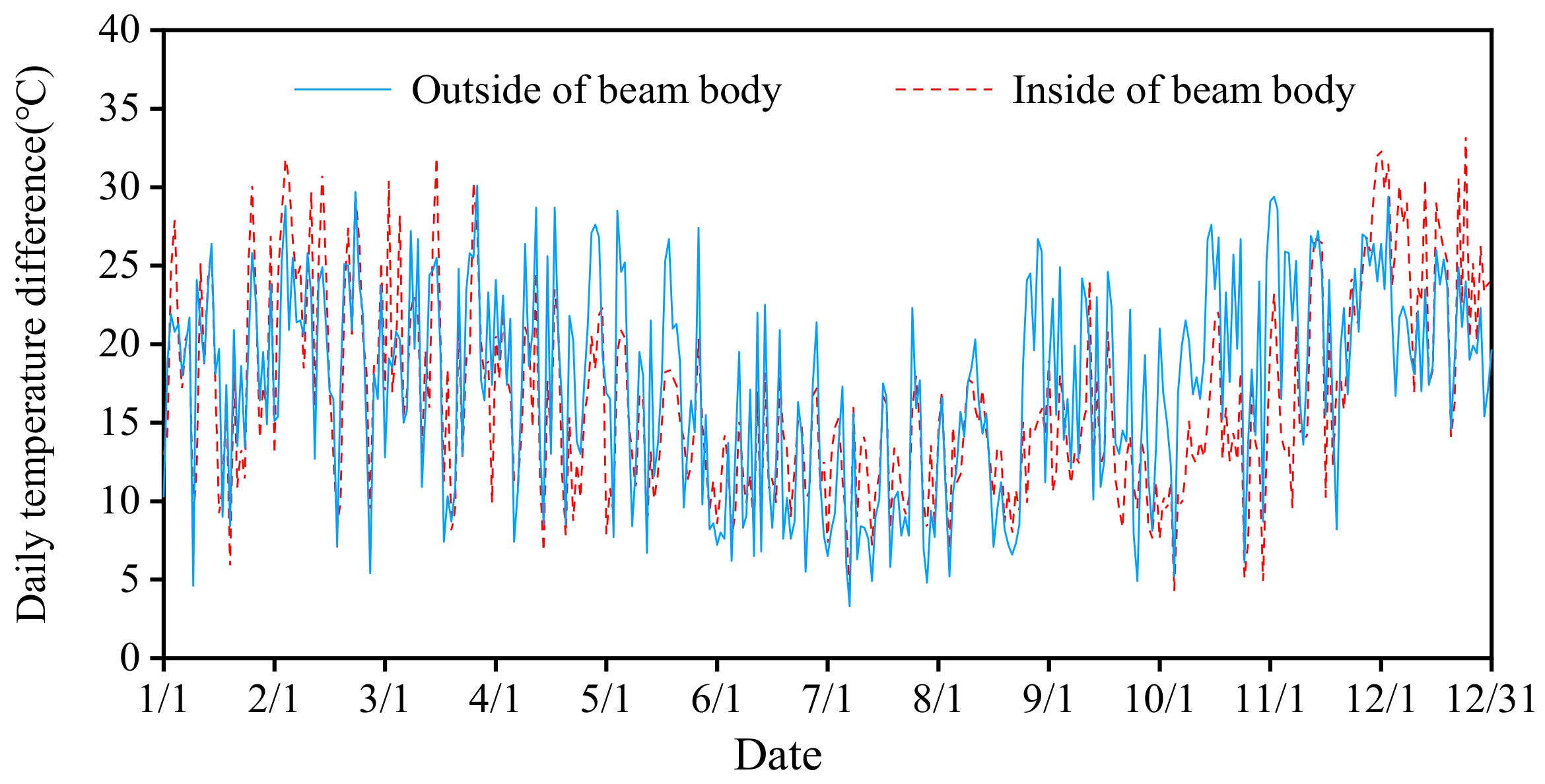
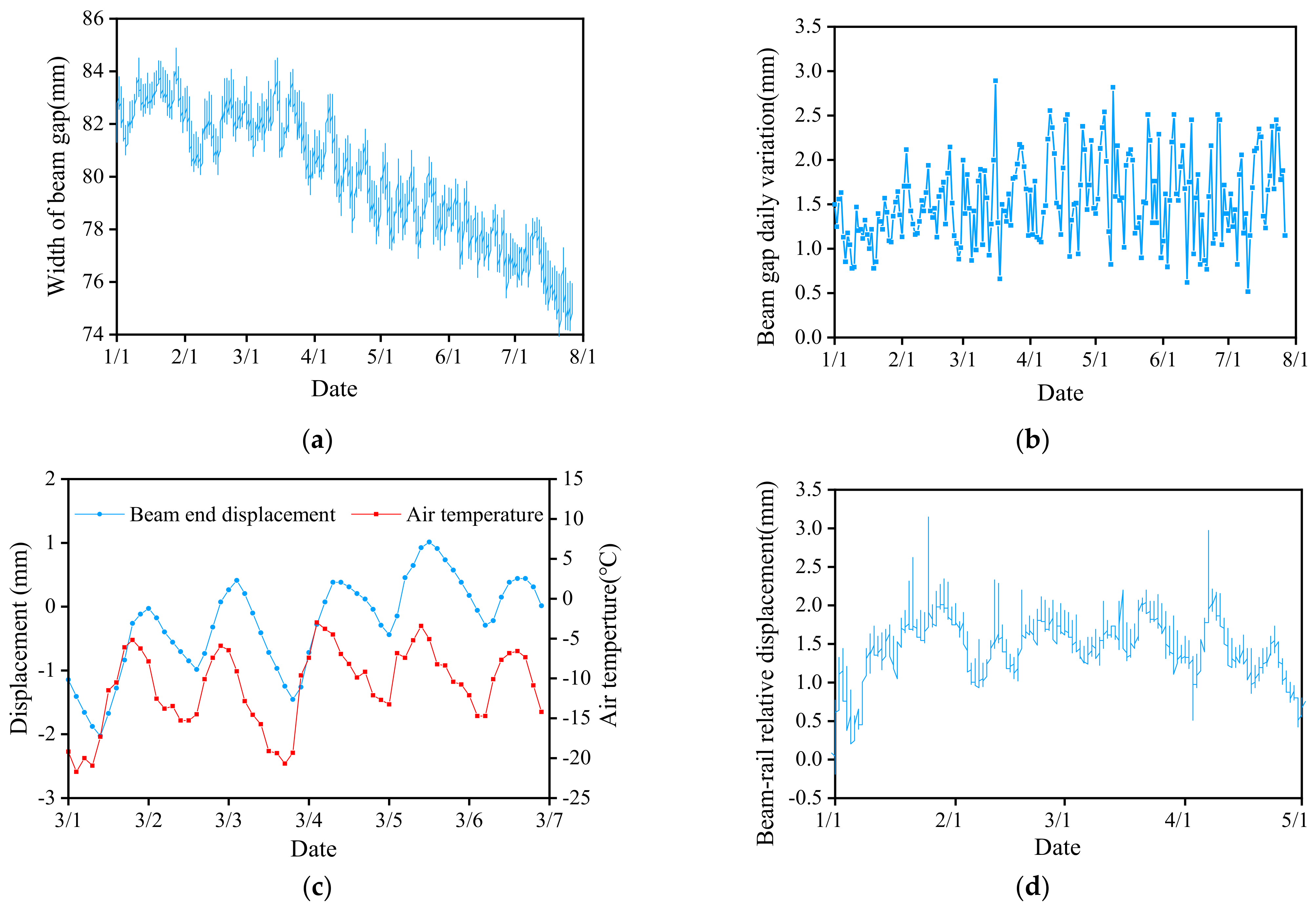
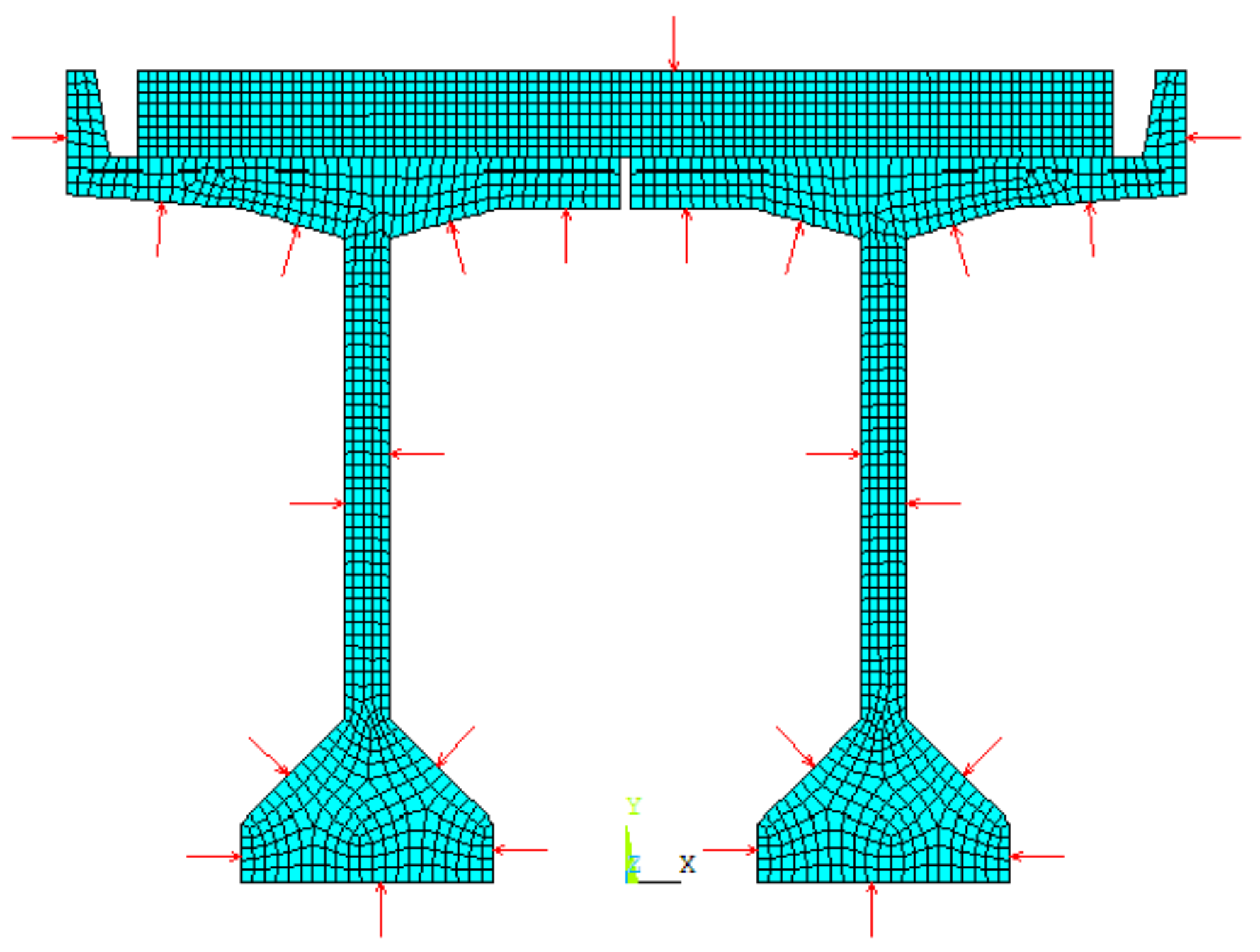




| Layout Location | Railway Mileage | Test System | Monitoring Content |
|---|---|---|---|
| Budongquan | K978 | Beam temperature monitoring system, beam-rail displacement monitoring system | Air temperature, beam temperature, beam end displacement and beam-rail longitudinal relative displacement |
| Tuotuohe | K1243 | Beam temperature monitoring system | Air temperature, beam temperature |
| Za’gya Zangbo | K1450 | Beam temperature monitoring system | Air temperature, beam temperature |
| Time | Position | Finite element Calculation Results (°C) | Measured Data (°C) | Error of Calculation |
|---|---|---|---|---|
| 7/31-5:00 | Internal measuring point | 6.59 | 6.60 | 0.15% |
| Outer measuring point | 6.13 | 6.10 | 0.49% | |
| 7/31-19:00 | Internal measuring point | 9.63 | 10.20 | 5.60% |
| Outer measuring point | 11.81 | 12.10 | 2.40% |
| Season | Tuotuohe Region | Za’gya Zangbo Region | ||
|---|---|---|---|---|
| Daily Beam Temperature Difference (°C) | Daily Air Temperature Difference (°C) | Daily Beam Temperature Difference (°C) | Daily Air Temperature Difference (°C) | |
| Spring | 9.76 | 18.30 | 16.84 | 21.90 |
| Summer | 5.96 | 10.90 | 10.91 | 13.20 |
| Autumn | 8.35 | 17.10 | 15.36 | 21.30 |
| Winter | 10.19 | 20.50 | 17.81 | 23.00 |
Publisher’s Note: MDPI stays neutral with regard to jurisdictional claims in published maps and institutional affiliations. |
© 2022 by the authors. Licensee MDPI, Basel, Switzerland. This article is an open access article distributed under the terms and conditions of the Creative Commons Attribution (CC BY) license (https://creativecommons.org/licenses/by/4.0/).
Share and Cite
Yan, B.; Cheng, R.; Xie, H.; Zhang, X. Temperature Load Mode of Bridge in Permafrost Region of Qinghai–Tibet Railway. Appl. Sci. 2022, 12, 4377. https://doi.org/10.3390/app12094377
Yan B, Cheng R, Xie H, Zhang X. Temperature Load Mode of Bridge in Permafrost Region of Qinghai–Tibet Railway. Applied Sciences. 2022; 12(9):4377. https://doi.org/10.3390/app12094377
Chicago/Turabian StyleYan, Bin, Ruiqi Cheng, Haoran Xie, and Xiangmin Zhang. 2022. "Temperature Load Mode of Bridge in Permafrost Region of Qinghai–Tibet Railway" Applied Sciences 12, no. 9: 4377. https://doi.org/10.3390/app12094377
APA StyleYan, B., Cheng, R., Xie, H., & Zhang, X. (2022). Temperature Load Mode of Bridge in Permafrost Region of Qinghai–Tibet Railway. Applied Sciences, 12(9), 4377. https://doi.org/10.3390/app12094377






